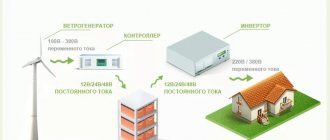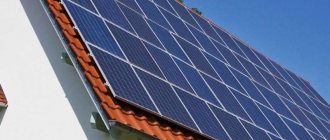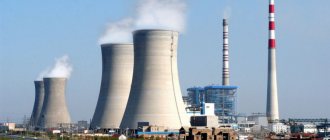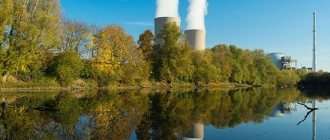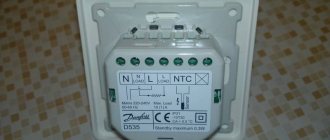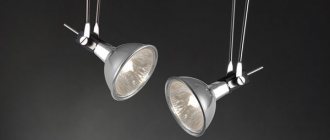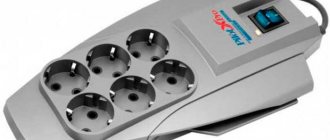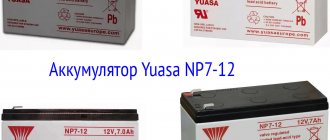Power plants are used to supply electricity to stationary and mobile objects. They are a set of installations, apparatus and equipment that are used to produce electricity, together with the buildings and structures necessary for this, located in a certain area. Modern power plants can start up in a short time and are protected from precipitation and mechanical impact. The largest projected is the Evenki hydroelectric power station.
Why are power plants needed?
The power plant can easily be called one of the most important structures necessary to ensure the livelihoods of the population. Without electricity today, not a single settlement or enterprise can exist. Modern power plants are built far from densely populated areas, consist of a complex of buildings and installations, and are divided into various types and types, united by a common principle. It lies in the fact that they all operate from a system of generators that produce energy through shaft rotation.
Energy systems (IES)
The entire energy system of Russia consists of a unified energy system (UES) and territorially isolated energy systems.
The UES includes 71 regional energy systems, which form 7 integrated energy systems (IES):
- East;
- Ural;
- Siberia;
- South;
- Middle Volga;
- North-West;
- Center.
All systems are connected by high-voltage power transmission lines with a voltage of 220-750 kV or more. They operate in synchronous mode. As of 2022, the capacity of all power plants in the country amounted to 246,342.45 MW.
Advantages of the unified energy system of Russia:
- reduction of the total maximum load of the UES of the Russian Federation by 5 GW;
- use of highly efficient large-block equipment;
- reducing the power demand of power plants by 10-12 GW;
- optimization of load distribution between power plants, which made it possible to reduce fuel consumption.
The energy system is managed by branches of SO UES JSC. Together with the UES of our country, the energy systems of Belarus, Kazakhstan, Ukraine, Azerbaijan, Lithuania, Georgia, Latvia, Estonia, and Mongolia operate. The systems of Kyrgyzstan and Uzbekistan operate through the Kazakh energy system in parallel with the Russian Unified Energy System. And through the Ukrainian energy system there is a connection with the system of Moldova.
The main technologically territorial isolated energy systems include:
- Kamchatka Krai;
- Magadan region;
- Northern part of the Sakha Republic (Yakutia);
- Sakhalin region;
- Chukotka Autonomous Okrug;
- Taimyr Autonomous Okrug.
Types of power plants
According to the method of generating energy, power plants are divided into:
- atomic. Energy is produced by nuclear reactors and a number of specialized installations and systems;
- thermal. The main one is external fuel, which, when burned, creates energy to turn the generator shaft;
- hydroelectric power stations. The main “force” is the natural energy of the rivers on which dams are installed;
- wind power plants. Depends on air masses;
- geothermal. They are powered by underwater thermal sources;
- sunny. Absorb and convert solar energy.
According to their purpose, power plants are divided into the following types:
- power. Necessary for power supply to large consumers, such as cities and factories;
- chargers. They are used to charge various accumulators and batteries, equipped with chargers, and the power plant must also include a DC electric drive;
- lighting Equipped with a complete set of spotlights and lamps, designed for lighting business facilities and construction sites;
- special. Used for welding and other types of work.
Power plants are also divided into:
- into variable and constant (according to the type of current);
- for diesel and gasoline (by engine type);
- for high-, medium- and low-power (in terms of power);
- for low and high voltage (voltage).
TPP and CHP: differences
Often people confuse these two concepts. CHP, in fact, as we found out, is one of the types of thermal power plants. Such a station differs from other types of thermal power plants primarily in that part of the thermal energy it generates goes to boilers installed in the premises to heat them or to produce hot water.
Also, people often confuse the names of hydroelectric power stations and state district power stations. This is primarily due to the similarity of abbreviations. However, a hydroelectric power station is fundamentally different from a state district power station. Both of these types of stations are built on rivers. However, at a hydroelectric power station, unlike state regional power plants, it is not steam that is used as an energy source, but the water flow itself.
Types of power plants
Power plants come in various types, the most common of which are:
- Thermal
- Hydraulic
- Atomic
Thermal stations that produce energy are quick to construct and inexpensive compared to other types. This type of power plant is able to operate properly without seasonal fluctuations. Despite their undeniable advantages, various types of power plants have several disadvantages of their own. For example, thermal power plants operate on non-renewable resources, create waste, and their operating mode changes slowly, since it takes several days to heat up the boiler plant.
Hydraulic power plants are more economical and easier to operate. Maintenance of these stations does not require large numbers of personnel. Among other things, hydroelectric power plants have a long useful life, exceeding 100 years, as well as maneuverability when the load changes. The low cost of energy produced is one of the reasons for the widespread use of hydraulic power plants today. The problem with hydroelectric power plants is that their construction takes from 15 to 20 years and the construction process is complicated by the flooding of large areas of fertile land. In some cases, additional problems may arise with choosing a location for constructing an object.
Nuclear power plants operate on nuclear fuel and are most often located in places where electrical energy is required, but there are no other sources of raw materials. About 25 tons of fuel allow the station to operate for several years. The operation of nuclear power plants does not cause an increase in the greenhouse effect, and the energy generation process is carried out without polluting the environment.
Basics of power plant operation
Regardless of what kind of power plants there are , they mostly use the energy of rotation of the generator shaft. The purpose of the generator is that it:
- Must ensure long-term stable parallel operation with power systems of various capacities, as well as operation on an autonomous load
- Undergoes instantaneous load shedding and resurgence comparable to its rated power
- Performs a protective function due to the presence of special devices
- Starts the engine that ensures the operation of the station
Power plants are the most optimal way to generate energy due to a number of factors. To date, there are no similar methods that can produce electricity on such a large scale.
Characteristics of industrial power plants
Industrial plants are power plants included in manufacturing enterprises. Their main purpose is to supply energy to the relevant enterprises and surrounding areas. The fundamental features of industrial stations include:
Based on the type of energy produced, industrial stations are divided into the following groups:
- Producing only electrical energy
- Supplying consumers with electricity and heat energy
- Additionally supplying consumers with compressed air
Depending on the type of engine installed, power plants with steam or gas turbines, internal combustion engines, and locomotives are distinguished.
In addition to the power and type of station, there are a number of other parameters and characteristics. The ability to connect individual consumer devices depends on the phase pattern of the station. There are single-phase and three-phase autonomous power plants. In a three-phase installation, the power is distributed evenly between all phases.
An equally important characteristic is the frequency of the current generated by the installation. In accordance with the standards, this figure is 50 Hz in Russia. In other countries, including Japan, Canada and the United States, this setting may be as high as 60 Hz. The maximum strength of the generated current of power plants is determined in amperes. It is not allowed to connect to the power installation a load whose amperage consumption exceeds the maximum current transmission capability of the unit.
Taking into account all the characteristics of power plants, it will be possible to ensure their maximum performance and stable operation over a long period of time. Depending on the presence or absence of specific technical characteristics, it is necessary to regulate the load on the station.
What are the requirements for thermal power plants?
A thermal power plant is a thermal power station where electricity is generated and consumed simultaneously. Therefore, such a complex must fully comply with a number of economic and technological requirements. This will ensure uninterrupted and reliable supply of electricity to consumers. So:
- thermal power plant premises must have good lighting, ventilation and aeration;
- the air inside and around the plant must be protected from contamination by solid particles, nitrogen, sulfur oxide, etc.;
- water supplies should be carefully protected from the ingress of wastewater;
- Water treatment systems at stations should be waste-free.
Diesel power plants
Diesel power plants are a very practical and effective solution to the problem of autonomous power supply to various types of objects.
Main advantages:
- low cost of generated electricity;
- quick payback;
- long service life and durability.
Despite the fact that the cost of a diesel power plant is much higher than a gasoline one, it is much cheaper to operate, which compensates for the difference in price. Also, diesel power plants, due to their greater engine life, can operate much longer than gasoline power plants. Due to these circumstances, diesel power plants have found their application as sources of constant or emergency power supply in continuous production. It is impossible not to note the high reliability and durability of diesel power plants.
Diesel power plants can be operated in the harshest weather conditions - at air temperatures from -50 to +50 *C. However, it should be remembered that the diesel engine is somewhat capricious in winter conditions, and different fuels are used at different times of the year.
Diesel power plants are also susceptible to temperature changes (for example, sharp frosts). The point here is this. Summer diesel fuel, which can be used without problems in the warm season, is not suitable for use in winter.
Due to the cold, paraffin precipitates in the fuel itself, which clogs the fuel lines. Therefore, winter diesel fuel is additionally processed and paraffin is removed. Naturally, it becomes more expensive than the summer one.
However, with all this, it is necessary to point out the obvious advantage of a diesel power plant - diesel fuel is not volatile, like gasoline vapors or gas. This provides the diesel engine with a kind of explosion protection, which is especially valuable for diesel power plants, often used as auxiliary units in the elimination of various disasters and accidents. Even a significant leak of diesel fuel does not pose a danger to others and workers.
Gasoline power plants
Gasoline power plants have their advantages:
- relatively low cost of equipment compared to other types;
- compactness;
- easy start-up at low temperatures;
- low noise level of the power plant;
- ease of operation.
The main purpose of gasoline power plants is as a source of power for a short time (up to 7-8 hours). Today, manufacturers of gasoline electric generators produce two types of power plants - with two-stroke and four-stroke engines. Engines of the first type are installed on low-power gasoline generators and mobile power stations.
Such installations are highly mobile and can be used in almost any conditions, so they can be called universal. More powerful stationary gas generators are equipped with four-stroke engines, providing higher power and a longer service life.
Mathematical models and methods used in thermal power plant control problems
As is known, the technological process on a vehicle consists of a step-by-step transformation of various types of energy. The technological process has a peculiarity - the final product - electricity - cannot be stored. An indirect indicator of the correspondence between the steam output of the boiler and the power of the turbine is the pressure of superheated steam.
Modern thermal power plants are divided into two types:
- Cross-linked. The main unit for steam and water are interconnected
- With block layout. With this type, the main equipment is described by a separate technological process within each power unit.
To describe technological processes and formulate control criteria, mathematical models
. They are depicted in the form of equations.
A typical power unit is usually chosen as a control object characterizing the technological process at a thermal power plant as a whole. The technological process occurring in such a block can be represented as two sequential processes: in a steam boiler and a turbogenerator.
Gas power plants
Main advantages of gas power plants:
- the service life of gas power plants is 25% higher than that of gasoline and diesel analogues;
- the gas generator is easy to maintain and install, and is highly reliable;
- cheaper in terms of consumables;
- clean, smokeless and less harmful exhaust;
- acceptable noise level.
Main purpose: use of a gas power plant as a source of backup or main power supply for an indefinite time interval (if connected to a gas pipeline).
The main advantage of a gas generator is that it is possible to simultaneously generate electricity and use the heat that is obtained as a result of the operation of a gas power plant. This heat can be used, for example, to heat buildings and other needs.
Gas-powered generators are divided depending on the design of the power units driving the generator. These can be gas piston engines or gas turbines.
Before purchasing a power plant, it is recommended to clearly assess the planned load on the device - this will be all devices operating using electric current (power calculation). Their rated power and phase connection are important. These are two main factors that will influence the initial selection of the generator you need.
The choice of power plant depends on several factors. First of all, this is, of course, determining the type of its engine, the generator itself and the phase pattern, and then the subsequent selection of the model according to certain characteristics and indicators.
Warmth is a priority
Combined heat and power plants (CHP) are another type of thermal power plant, but this is not a condensing plant, but a heating plant. CHP plants mainly produce heat - in the form of process steam and hot water (including for hot water supply and heating of residential and industrial facilities). Therefore, CHP plants are a key element in centralized heat supply systems in cities, in terms of the level of penetration of which Russia is one of the world leaders. Medium and small thermal power plants are also indispensable satellites of large industrial enterprises. The key feature of CHP is cogeneration: simultaneous production of heat and electricity. This is both more efficient and more profitable than generating, for example, only electricity (as in state district power plants) or only heat (as in boiler houses). That is why the USSR at one time relied on the widespread development of district heating.
The fundamental difference between thermal power plants and state district power plants is that all these are boiler-turbine and steam-turbine power plants - different types of turbines. Cogeneration turbines of the “T” type are installed at thermal power plants, the difference between which and the condensing turbines of the “K” type (which operate at state district power plants) is the presence of controlled steam extraction. Subsequently, it is sent, for example, to network water heaters, from where it goes to apartment radiators or hot water taps. Historically, the most widespread in our country are the T-100 turbines, the so-called “hundreds”. But back-pressure turbines of the “P” type also work at thermal power plants, which produce process steam (they do not have a condenser and the steam, after generating electricity in the flow part, goes directly to the industrial consumer). There are also turbines of the “PT” type, which can work for both industry and district heating.
In “K” type turbines, the process of steam expansion in the flow section ends with its condensation (which makes it possible to obtain greater power in one installation - up to 1.6 GW or more).
Alexey Kutyrev Head of the Operation Department of Thermal Power Plants of the Kuzbass Branch
“For thermal power plants, electricity, unlike state district power plants, is a by-product; such stations in the USSR and Russia work primarily to heat the coolant - and generate heat, which then goes to residential buildings or industrial enterprises in the form of steam. And how much electricity is produced in the end is not so important. It is important to provide the necessary gigacalories so that consumers, mainly the population, feel comfortable.”
During the heating season, CHP plants operate according to the so-called “thermal schedule” - they maintain the temperature of the network water in the main depending on the outside air temperature. In this mode, CHP plants can also carry the base load of electricity, demonstrating, by the way, very high installed capacity utilization factors (IUR). According to the electrical schedule, CHP plants usually operate in the warm months of the year, when the heating output from the turbines is turned off. State district power plants operate exclusively according to an electrical schedule.
It is not difficult to guess that thermal power plants in Russia are much larger than state regional power plants - and all of them, as a rule, differ greatly in power. There are also a great variety of options for their work. Some thermal power plants, for example, operate as state district power plants - such as, for example, CHPP-10. Others operate in close conjunction with industrial enterprises - and therefore do not reduce their capacity even in the summer. For example, Kazan CHPP-3 TGK-16 supplies steam to the chemical industry giant Kazanorgsintez (both companies are part of the TAIF Group). And the Novo-Kemerovskaya CHPP of the SGK generates steam for the needs of KAO Azot. Some stations provide heat and hot water primarily to the population - for example, all four thermal power plants in Novosibirsk have practically stopped producing process steam since the 1990s.
It happens that combined heat and power plants do not produce electrical energy at all - although these are now in the minority. This is due to the fact that, unlike gigacalories, the cost of which is strictly regulated by the state, kilowatts in Russia are a market product. Under these conditions, even those thermal power plants that had not previously worked on the wholesale electricity and capacity market tried to enter it. In the structure of the SGC, for example, Krasnoyarsk CHPP-3 went through this path, which until March 2012 produced only thermal energy. But on March 1 of that year, the first coal-fired power unit in Russia with a capacity of 208 MW, built under the CSA, was put into operation. Since then, this station has generally become an exemplary one in the SGC in terms of energy efficiency and environmental friendliness.
Until March 2012, Krasnoyarsk CHPP-3 produced only thermal energy. And now it is exemplary in the SGC in terms of energy efficiency and environmental friendliness.
The largest thermal power plants in Russia operate on gas and are under the wing of Mosenergo. The most powerful can probably be considered CHPP-26, located in the Biryulyovo Zapadnoe district of Moscow - at least in terms of electrical power of 1841 MW, it is ahead of all other CHPPs in the country. This power plant provides centralized heat supply to industrial enterprises, public and residential buildings with a population of more than 2 million people in the Chertanovo, Yasenevo, Biryulevo and Maryino districts. The thermal power of this thermal power plant, although high (4214 Gcal/hour), is not a record. CHPP-21 of the same Mosenergo has a higher heat capacity - 4918 Gcal/hour, although in terms of electricity it is slightly inferior to its “colleague” (1.76 GW).
Advantages of nuclear power plants over thermal power plants
The advantages and disadvantages of nuclear power plants depend on what type of electricity generation we compare nuclear energy with. Since the main competitors of nuclear power plants are thermal power plants and hydroelectric power stations, let us compare the advantages and disadvantages of nuclear power plants in relation to these types of energy production.
TPPs, that is, thermal power plants, are of two types:
- Condensing or briefly CESs serve only to produce electricity. By the way, their other name comes from the Soviet past, IESs are also called GRESs - short for “state district power plant”. 2. Combined heat and power plants or combined heat and power plants only allow producing not only electrical, but also thermal energy. Taking, for example, a residential building, it is clear that CES will only provide electricity to the apartments, and CHP will also provide heating in addition.
As a rule, thermal power plants operate on cheap organic fuel - coal or coal dust and fuel oil. The most popular energy resources today are coal, oil and gas. According to experts, the world's coal reserves will last for another 270 years, oil – for 50 years, gas – for 70. Even a schoolchild understands that 50-year reserves are very small and must be protected, and not burned in furnaces every day.
Nuclear power plants solve the problem of shortage of organic fuel. The advantage of nuclear power plants is the elimination of fossil fuels, thereby preserving endangered gas, coal and oil. Instead, nuclear power plants use uranium. World uranium reserves are estimated at 6,306,300 tons. No one is counting how many years it will last, because... There are a lot of reserves, uranium consumption is quite small, and there is no need to think about its disappearance yet. In extreme cases, if uranium reserves are suddenly carried away by aliens or they evaporate on their own, plutonium and thorium can be used as nuclear fuel. Converting them into nuclear fuel is still expensive and difficult, but it is possible.
The advantages of nuclear power plants over thermal power plants include a reduction in the amount of harmful emissions into the atmosphere.
What is released into the atmosphere during the operation of thermal power plants and thermal power plants and how dangerous it is:
- Sulfur dioxide or sulfur dioxide is a dangerous gas that is harmful to plants. If ingested in large quantities, it causes coughing and suffocation. When combined with water, sulfur dioxide turns into sulfurous acid. It is thanks to sulfur dioxide emissions that there is a risk of acid rain, which is dangerous for nature and humans. 2. Nitrogen oxides are dangerous for the respiratory system of humans and animals, irritating the respiratory tract. 3. Benapyrene is dangerous because it tends to accumulate in the human body. Long-term exposure may cause malignant tumors.
The total annual emissions of thermal power plants per 1000 MW of installed capacity are 13 thousand tons per year at gas and 165 thousand tons at pulverized coal thermal stations. A thermal power plant with a capacity of 1000 MW per year consumes 8 million tons of oxygen to oxidize fuel; the advantages of nuclear power plants are that in nuclear energy oxygen is not consumed in principle.
The above emissions are also not typical for nuclear power plants. The advantage of nuclear power plants is that emissions of harmful substances into the atmosphere at nuclear power plants are negligible and, compared to emissions from thermal power plants, are harmless.
The advantages of nuclear power plants over thermal power plants are low fuel transportation costs. Coal and gas are extremely expensive to transport to factories, while the uranium needed for nuclear reactions can be placed in one small truck.
The main thing is electricity
The designation “GRES” is a relic of the Soviet industrial megaproject, at the initial stage of which, within the framework of the GOELRO plan, the task of eliminating the shortage, first of all, of electrical energy was solved. It simply stands for “state regional power station.” In the USSR, districts were called territorial associations (industry with population) in which a unified energy supply could be organized. And at key geographical points, usually near large deposits of raw materials that could be used as fuel, state district power plants were installed. However, gas can be supplied to such stations through pipelines, and coal, fuel oil and other types of fuel can be delivered by rail. And to the Berezovskaya State District Power Plant in Sharypovo, Krasnoyarsk, coal generally arrives along a 14-kilometer conveyor belt.
In the modern understanding, a state district power plant is a condensing power plant (CPS), which is very powerful compared to a thermal power plant. After all, the main task of such a station is to generate electricity, and in the basic mode (that is, evenly throughout the day, month or year). Therefore, state district power plants, as a rule, are located far from large cities - thanks to power lines, such generation facilities operate for the entire energy system. And even for export - like, for example, the Gusinoozerskaya State District Power Plant in Buryatia, which since its launch in 1976 has provided the lion's share of supplies to Mongolia. And fulfilling the role of a “hot reserve” for this country.
It is interesting that not all stations with the abbreviation “GRES” in their names are condensing ones; some of them have been operating as thermal power plants for a long time. For example, Kemerovo State District Power Plant of Siberian Generating Company. Coal consumption for electricity and heat at the station today is in the proportion of 50 to 50,” explains Alexey Kutyrev, head of the TPP operation department of the Kuzbass branch of SGK, to Oxygen.LIFE.
At the same time, at other state district power plants that are part of the SGC - for example, at Tom-Usinskaya (1345.4 MW) and Belovskaya (1260 MW) in Kuzbass, as well as at Nazarovskaya (1308 MW) in the Krasnoyarsk Territory - 97% of the coal burned is to generate electricity. And only 3% goes to heat generation. And the picture is the same, with rare exceptions - at almost any other state district power station.
Alexey Kutyrev Head of the Operation Department of Thermal Power Plants of the Kuzbass Branch
“For thermal power plants, electricity, unlike state district power plants, is a by-product; such stations in the USSR and Russia work primarily to heat the coolant - and generate heat, which then goes to residential buildings or industrial enterprises in the form of steam. And how much electricity is produced in the end is not so important. It is important to provide the necessary gigacalories so that consumers, mainly the population, feel comfortable.”
The largest thermal power plant in Russia and the third thermal station in the world is Surgutskaya SDPP-2 (part of Unipro) - its capacity is 5657.1 MW (only two hydroelectric power stations in our country, Sayano-Shushenskaya and Krasnoyarsk, are more powerful). With a fairly decent capacity factor of more than 64.5%, this station generated almost 32 billion kWh of electrical energy in 2022. This power plant runs on associated oil and natural gas. The largest power plant in the country operating on solid fuel (coal) is Reftinskaya - it is located 100 km from Yekaterinburg. 3.8 GW of electrical power allows generating volumes that cover 40% of the needs of the entire Sverdlovsk region. Ekibastuz coal is used as the main fuel at the station.
Kemerovo State District Power Plant has long been repurposed into a classic combined heat and power plant; it retains only its historical name - State District Power Plant.
Disadvantages of nuclear power plants over thermal power plants
- The disadvantages of nuclear power plants over thermal power plants are, first of all, the presence of radioactive waste. They try to recycle radioactive waste at nuclear plants as much as possible, but they cannot dispose of it at all. The final waste at modern nuclear power plants is processed into glass and stored in special storage facilities. Whether they will ever be used is still unknown. 2. The disadvantages of nuclear power plants are their low efficiency compared to thermal power plants. Since processes in thermal power plants occur at higher temperatures, they are more productive. It is still difficult to achieve this in nuclear power plants, because zirconium alloys, which indirectly participate in nuclear reactions, cannot withstand extremely high temperatures. 3. The general problem of heat and nuclear power plants stands apart. The disadvantage of nuclear power plants and thermal power plants is thermal pollution of the atmosphere. What does it mean? When generating nuclear energy, a large amount of thermal energy is released, which is released into the environment. Thermal pollution of the atmosphere is a problem of today, it entails many problems such as the creation of heat islands, changes in microclimate and, ultimately, global warming.
Modern nuclear power plants already solve the problem of thermal pollution and use their own artificial pools or cooling towers (special cooling towers for cooling large volumes of hot water) to cool water.
Principle of operation
To begin with, it is worth defining the terms “CHP” and “CHP”. In simple terms, they are sisters. A “clean” thermal power plant - a thermal power plant is designed exclusively for the production of electricity. Its other name is “condensing power plant” - IES.
Combined heat and power plant - CHP - a type of thermal power plant. In addition to generating electricity, it supplies hot water to the central heating system and for domestic needs.
The operation scheme of a thermal power plant is quite simple. Fuel and heated air—an oxidizer—simultaneously enter the furnace. The most common fuel at Russian thermal power plants is crushed coal. The heat from the combustion of coal dust turns the water entering the boiler into steam, which is then supplied under pressure to the steam turbine. A powerful flow of steam causes it to rotate, driving the generator rotor, which converts mechanical energy into electrical energy.
Next, the steam, which has already significantly lost its initial indicators - temperature and pressure - enters the condenser, where after a cold “water shower” it again becomes water. Then the condensate pump pumps it into the regenerative heaters and then into the deaerator. There, the water is freed from gases - oxygen and CO2, which can cause corrosion. After this, the water is reheated from steam and fed back into the boiler.
Advantages and disadvantages of nuclear power plants over hydroelectric power plants
The advantages and disadvantages of nuclear power plants over hydroelectric power plants are mainly related to the dependence of hydroelectric power stations on natural resources. More about this...
- The advantage of nuclear power plants over hydroelectric power plants is the theoretical possibility of building new nuclear power plants, while most rivers and reservoirs capable of working for the benefit of hydroelectric power plants are already occupied. That is, the opening of new hydroelectric power stations is difficult due to the lack of necessary places. 2. The next advantage of nuclear power plants over hydroelectric power plants is their indirect dependence on natural resources. Hydroelectric power plants directly depend on the natural reservoir, nuclear power plants only indirectly on uranium mining, everything else is provided by the people themselves and their inventions.
The disadvantages of nuclear power plants compared to water stations are insignificant - the resources that a nuclear power plant uses for a nuclear reaction, and specifically uranium fuel, are not renewable. While the amount of water, the main renewable resource of a hydroelectric power station, will not change in any way from the operation of a hydroelectric power station, and uranium itself cannot be restored in nature.
Nuclear power plant protective mechanisms
All nuclear power plants are required to be equipped with comprehensive safety systems, for example:
- localizing – limiting the spread of harmful substances in the event of an accident resulting in the release of radiation;
- providing – supply a certain amount of energy for stable operation of systems;
- managers - serve to ensure that all protective systems function normally.
In addition, the reactor can be shut down in an emergency. In this case, automatic protection will interrupt chain reactions if the temperature in the reactor continues to rise. This measure will subsequently require serious restoration work to return the reactor to operation.
After a dangerous accident occurred at the Chernobyl nuclear power plant, the cause of which was an imperfect reactor design, they began to pay more attention to protective measures, and also carried out design work to ensure greater reliability of the reactors.
Non-traditional sources of electricity
Non-traditional sources are represented by geothermal power plants (Fig. 1), operating on thermal energy coming from the bowels of the earth. The deeper from the earth's surface, the higher the temperature of this layer. In Russia, such installations were built in Kamchatka and the Kuril Islands.
There are designs of tidal power plants (Fig. 2), which operate from the energy created by the ebb and flow of tides at the narrowest point of an artificial bay, cut off from the sea. An example is the experimental Kislogubskaya TPP, built on the Kola Peninsula.
The classification of power plants includes solar and wind alternative installations (Fig. 3). All types of such systems provide electricity to small enterprises and industries and are used in the private sector to meet domestic needs. Basically, these are areas and places where there is no centralized power supply and there is no possibility of connecting to ordinary power lines.
Preview:
Technological lesson map
Fuel and energy complex. Electric power industry
Lesson type: combined
Goals and objectives:
- Show the importance, role and composition of the Russian electric power industry
- To form an idea of the main types of power plants and their location
- Identify problems in the electricity industry
- Develop the ability to work with various sources of geographic information.
- To form an ecological culture, a consciousness of careful and economical use of electricity.
Types of student activities:
frontal survey on the material covered; independent group work (or work in pairs) with a textbook: with text, visual and cartographic material; analysis of maps, compilation of a systematizing table.
Due to the lack of local consumers and power systems, there are proposals for discrete operation of a power plant for an energy-intensive consumer - a regulator, for example, the production of hydrogen, which is then transported to possible consumers. Options for exporting electricity to countries in South Asia are also being considered.
Kislogubskaya TPP is an experimental tidal power plant located in the Kislaya Bay of the Barents Sea near the village of Ura-Guba, Murmansk Region. The first and only tidal power plant in Russia. It is registered with the state as a monument of science and technology.
Alternative energy sources
These include all other methods of generating energy, the most common of which are: solar power plant, wind power plant and tidal power plant.
Solar power plants
They use the energy of the sun, there are several ways to obtain it, we will look at this in another article.
Wind power station
- a power plant that uses wind energy.
Tidal power plants
generally speaking about themselves.
Power is a key parameter of a household power plant
The main technical parameter of any power plant is power. Manufacturers of household power plants indicate a maximum power level that is achieved only in short periods of time. To calculate the actual power level, it is necessary to additionally take into account the power factor. Actual performance is usually less than the maximum and is determined in kilowatts.
Household power plants of different types have the following power:
- Gasoline: 15-20 kW
- Diesel: up to 3000 kW
Generators with different outputs differ from each other in size, weight, cost and other parameters. When choosing a household power plant, you should consider all the characteristics together, including the efficiency indicated in the documentation provided for the unit.
